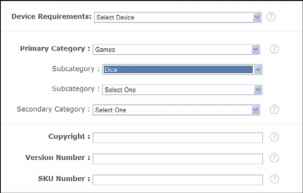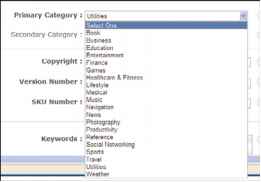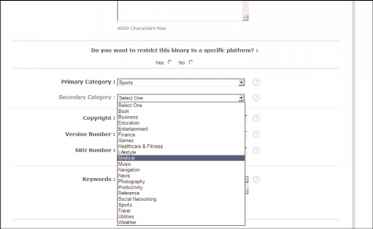Segmenting Your Market
by interests and find that you sell most of your apps to people who are avid fishermen or sports enthusiasts.
Many independent developers stop after segmenting their market once, thinking they have enough information to be able to identify and communicate with their most likely customers. However, larger, more successful app development companies will attempt to push on further to find out even more information about their customers' lifestyles, values, life stage, and so on.
Let's define some terms that you will come across as you segment your iPhone/iPad app market. Obviously we could mention other segments, but these are some of the most common:
• Demographics refer to age, sex, income, education, race, marital status, size of household, geographic location, and profession. An understanding of demographics helps you define your marketing message and define a suitable marketing plan. Every app caters to at least one of these components.
• Lifestyle refers to the collective choice of hobbies, recreational pursuits, entertainment, vacations, and other nonwork-time pursuits. Some apps are strictly for fun, and so you should position your app in the appropriate category on the App Store. Other apps are health-related and therefore should be placed into this category on the App Store.
• Belief and value systems include religious, political, nationalistic, and cultural beliefs and values. These types of apps include religious topics, sermons, speeches (political and religious), and so on.
• Life stage refers to the chronological benchmarking of people's lives at different ages (for example, pre-teens, teenagers, empty-nesters, and so on). Many games can be classified in this category but also other apps such as health and fitness apps.
The App Store requires you to segment your market to some degree when you specify the category in which to place your app. Think very carefully about the category you select for your app. This can impact your sales dramatically if someone does a Power Search on the App Store by category and does not find your app where it logically should reside. Some apps and their category placement are clear cut, such as games. As a developer, you know when you post your game app to the store that you will select the Games category to post it. You can then further specify in a subcategory that the Game is a "Dice" game, as shown in Figure 4.2. Other apps are not as simple to categorize. Perhaps you have written an app that helps someone locate a friend. The app could be placed in the Navigation category, or it could be placed in the Social Networking category. Still, someone else may have developed an app that is educational as well as entertaining. That app could go in the Entertainment or Education category. The best category for your app is where you believe your buyers would most likely search on it.

- Figure 4.2 The Games category allows you to select up to two subcategories to help direct the buyer to your app.
H Note
If you are struggling to figure out to which category to post your app, ask your friends which location they would naturally search on the App Store for such an app. Ask 15-20 people to get a good sample. A clear trend should emerge of one category over another. If you feel that your app is in the wrong category after posting, you can change it at any time by going to iTunes Connect, logging in, and editing your app's profile information.
A list of App Store categories is shown in Figure 4.3 from the iTunes Connect website, where you will add your apps and select a primary category in which to place your app. You may also select a secondary category if needed. For example, you could select Sports as a primary category and Medical as a secondary category if you are selling an app that helps someone do cardio training, as shown in Figure 4.4. Because the Games category is so large, the App Store provides sub-categories for this section. At the time of this writing, no other category allowed for more than one subcategory.

- Figure 4.3 iTunes Connect website allows you to add new iPhone/iPad apps and select a primary and secondary category for your app. Selecting the right category for your app will help you to segment your market.

- Figure 4.4 iTunes Connect also allows you to enter an optional secondary category to help further segment your market.
How can you find out more about your potential iPhone/iPad app customers? The most effective means is through some level of market research. Larger companies segment their markets by conducting extensive market research projects, consisting of several rounds of exploratory research. They do customer and product data collection. Professional researchers gather data from users of similar products on
• Number and timing of purchases
• Reasons for purchases
• Consumers' attitudes about various product attributes
• Importance of the product to the lifestyle of consumer
But how can you find out more about your customers with budget and time constraints? What can an independent iPhone/iPad app developer do to segment her market?
Read the reviews posted on the App Store to gather valuable information on what customers like and don't like about your competitor's apps. Customer reviews are brutally honest with both praise and criticism. The comments will help you gain an understanding of how people perceive the app, its audience, and overall satisfaction. Obviously the more positive reviews than negative (based on the five-star rating) indicates the overall impression of the customer base. A predominantly high number of positive reviews indicates strong acceptance of the app. This also means that the app is resonating with a particular market segment. There will always be a few complainers who give the app a one-star rating, but if the majority of reviews are single star, then it is reason for concern. An example of an app receiving a good review is shown in Figure 4.5. The next example shows an app with a high number of negative reviews, displayed in Figure 4.6.
CUSTOMER RATINGS
* Average rail™] for ' ">:' current * * * * ~ rjihrgi
► Artngaliiliiiyior¿illYuruian:;. ^ + fljrr [hit auphijlujn: Sr.-' :
► Artngaliiliiiyior¿illYuruian:;. ^ + fljrr [hit auphijlujn: Sr.-' :
CUSTOMER REVIEWS K »e™™i H>r Tl* turret« version®
1D7 Hcvirwi 1w All Ue r nun W wmtjHrwiM®
Figure 4.5 An example of an app with generally positive reviews. Read the customer comments of apps that are similar to yours to understand what types of customers are buying this app. This will help you segment your market and see what customers like about the app.

- Figure 4.6 An example of an app with poor reviews. The customers will indicate why the app is not doing well. Comments like "App is not worth the money" indicate that the app is poorly written and obviously not really resonating with any market segment.
H Note
If an app is receiving mixed reviews, meaning the number of positive reviews is roughly equal to the number of negative reviews, you should very carefully read reviews as they usually indicate that the app is hitting a part of their target market but leaving the other part unsatisfied. The reviews always indicate what feature or features are missing from the app.
If you have multiple apps in your brand, you could have a different target audience based on the types of apps you have developed. For example, you may have developed game apps for children and teens, two markets that you would segment differently based on their needs. If you are selling a single app, you should look to target only one segment. Spill over into other segments is always a nice benefit, but you should focus on one market segment for best results.
Picking Your Market Segment
Picking the right market segment also means that the segment is
• Measurable in quantitative terms (how many? who are they?)—If you are developing a game app, try to figure out the potential size of your market. You can estimate your market by doing an Internet search and gathering some general statistics on its overall size. But trying to figure out your market segment size is difficult. You're better off determining who they are. For example, your game market may be young women 13-17 who are followers of the latest movie sensation.
• Substantial enough to generate planned sales volume through planned marketing activities—One thing is certain: You must have a market large enough to generate sufficient sales. If you develop an app that has a market that can be counted in just a few thousand, you may have a difficult time reaching them. The biggest reason is there is no way to know how many potential buyers in that small market own an iPhone/iPad or an iPod Touch. There must be enough target buyers on a frequent enough basis to sustain your company sales, spending, and profits from month to month.
You should also examine other important factors around targeting that could affect your app's success:
• Strength of competitors to attract your targeted buyers away from your app. How loyal are your customers? Could they be easily persuaded to switch to a competitor based on their marketing efforts (better pricing, better graphics, and so on)?
• Similarity of competitive apps in the buyers' minds. If the customer sees little difference in your app versus a competitors', you will have a
• Rate of new app introductions by competitors. If innovation is the key to success in your market and you are asleep at the wheel, the competition will eventually overtake you.
Perhaps the driving force behind targeted marketing or "segmentation" is the need to satisfy and keep those consumers who really love your apps. Even large iPhone/iPad development companies have embraced targeted marketing, continuing to refine and target their product offerings to different buyer groups.
Marketers of most products know that "20 percent of your buyers consume 80 percent of product volume." If you could identify the buyers that make up that key 20 percent and focus efforts on finding others like them, you could sell much more product with much less effort. Why? Because you're not spending your marketing efforts convincing the buyer they need your application—your efforts are spent targeting the potential buyers that already need your application. You just need to convince them that you are different (and better) than the competition.
Targeting existing buyers of similar apps is a great way to expand your business because they don't need to be convinced to purchase your apps. The buyer is already looking for an app like yours. Someone has already done the heavy lifting and made buyers out of them. Apple provides this help for your app automatically within the App Store. In the bottom of your product screen, there is a note that says "CUSTOMERS ALSO BOUGHT...," as shown in Figure 4.7.
problem.
Continue reading here: Selecting Your Social Media Tools
Was this article helpful?


